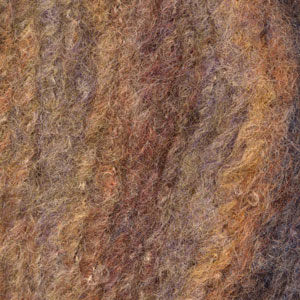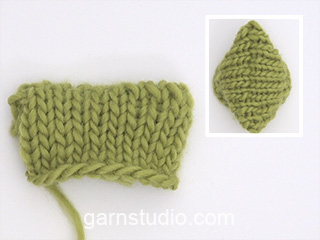DROPS 72-2 |
|||||||||||||
 |
 |
||||||||||||
DROPS Cardigan and vest and wristwarmers.
DROPS 72-2 |
|||||||||||||
|
Gauge: 9 sts x 14 rows in stockinette st = 10 x 10 cm Garter st, when knitting flat: Knit all sts, all rows. Decreasing tips (for neck): All decs are made on right side rows inside 9 edge sts in garter st and increased collar sts as follows: After edge sts + collar sts: sl 1, K 1, psso. Before edge sts + collar sts: K 2 tog. Back: Cast on 48-52-56-60 sts. Knit 10 rows garter st, change to stockinette st. When the piece measures 48-50-51-52 cm bind off for armhole at each side every other row: 3 sts 1-1-1-1 time, 2 sts 0-1-1-2 times and 1 st 4-3-5-4 times = 34-36-36-38 sts. When the piece measures 68-70-72-74 cm bind off the center 10-12-12-12 sts for the neck. Dec 1 st at each neck edge on the next row = 11-11-11-12 sts remain on each shoulder. Bind off when the piece measures 70-72-74-76 cm. Left front: Cast on 29-31-33-35 sts. Knit 10 rows garter st, change to stockinette st, but keep the 9 edge sts at the front edge in garter st throughout. Read the entire next section before knitting Collar: When the piece measures 32-33-34-35 cm inc 1 st inside 1 edge st at the center front for collar - knit the increased sts in garter st. On the following 2 rows knit garter st over only the outermost 10 sts (short rows). Then knit 2 rows over all sts, then on the next row inc 1 st inside 1 edge st. On the following 2 rows knit garter st over only the outermost 10 sts (short rows). Then inc 1 st inside 1 edge st 6 times every other row then 6 times every 4 rows = 14 sts increased for collar. Neck shaping: At the same time when the piece measures 36-37-38-39 cm shape the neck (continue to inc for collar – dec inside the 9 garter st button band sts + the collar sts - see knitting tips). Dec 1 st 6-7-7-7 times every other row and then 1 st 5-5-5-5 times every 4 row. Armhole: At the same time when the piece measures 48-50-51-52 cm bind off for armhole at the side as on back. After neck and armhole shaping is complete continue with 2-2-2-3 sts stockinette st at the side and the remaining sts in garter st. When the piece measures 70-72-74-76 cm bind off the 11-11-11-12 shoulder sts. The 14 garter st collar sts remain on needles. Continue in garter st over these sts as follows: * 2 rows garter st over all sts, 2 rows garter st over only the outermost 10 sts (short rows) *, repeat from * - * until the collar measures approx. 7-8-8-8 cm (to center back). Put all sts on a st holder. Right front: Cast on and knit the same as the left front, reversing all shaping. Sleeve: Cast on 26-27-27-28 sts. Knit garter st for 14 cm . Change to stockinette st, and inc 1 st at each side every 5-5-4.5-3.5 cm cm 7-7-7-8 times = 40-41-41-44 sts. When sleeve measures 48-47-45-44 cm bind off for sleeve cap at each side every other row: 3 sts 1-1-1-0 time, 2 sts 2-1-1-1 times and 1 st 2-4-6-7 times, then bind off 2 sts at each side every other row until the piece measures 58 cm. Bind off the remaining sts. Assembly: Sew shoulder seams. Weave the collar together at center back and sew the collar to neck. Sew in sleeves. Sew sleeve and side seams. Belt: Cast on 7 sts and knit garter st for approx. 125 cm , or to desired length. Bind off. VEST AND WRISTWARMERS IN ALPACA AND SILKE-TWEED: Sizes: S - M - L - XL Finished measurements: Bust: 88-94-100-106 cm Waist: 80-86-92-98 cm Materials: DROPS ALPACA from Garnstudio 200-200-200-250 g. col. no. 401, brown. 50 - 50 - 50 - 50 g. col. no. 4400, dark plum. and use: Garnstudio SILKE-TWEED from Garnstudio 50 - 50 - 50 - 50 g. col. no. 02, brown. 50 - 50 - 50 - 50 g. col. no. 09, flint. DROPS 3.5 mm and 4.5 mm needles, or sizes needed to obtain correct gauge. 5 DROPS Coconut buttons, nr 516 Gauge: 21 sts x 40 rows on larger needles in garter st = 10 x 10 cm. Garter st, when knitting flat: Knit all sts, all rows. Pattern: See chart. The pattern is seen from the right side. 1 row of chart = 2 rows garter st. Knitting tips (for armhole and neck): In the instructions in this knitting tip numbers for armhole are in front of ( ); numbers for neck are in ( ). All decs are made on right side rows inside 4 (6) sts knit as follows from edge: 3 (5) sts garter st then P 1 (as seen from the right side – K this st on wrong side rows). These 4 (6) sts are knit in brown Alpaca throughout. After 4 (6) edge sts: K 2 tog. Before 4 (6) edge sts: sl 1, K 1, psso. Back: Cast on 86-93-99-105 sts on smaller needles with brown Alpaca. Knit Pattern 1, and after 10 rows change to larger needles. Read the entire next section before knitting: After Pattern 1 knit Pattern 2, then Pattern 1 and Pattern 2 again, then knit garter st with brown Alpaca to finished measurements. At the same time when the piece measures 6 cm inc 1 st at each side every 4-4-5-5 cm a total of 4 times = 94-101-107-113 sts. At the same time when the piece measures 28-29-31-32 cm bind off 4-4-5-6 sts at each side for armhole. Then dec 1 st for armhole inside 4 edge sts every other row a total of 5-8-10-11 times - see knitting tips = 76-77-77-79 sts. After all shaping is complete, continue to knit 4 edge sts at each side as explained under decreasing tips. Read the entire next section before knitting When the piece measures 48-50-52-54 cm bind off the center 24-25-25-27 sts for the neck. Then dec 1 st at each neck edge inside 6 edge sts every other row 2 times - see knitting tips. At the same time when the piece measures 48-50-52-54 cm bind off 6 sts from side edge every other row 4 times for shoulder. When all sts are bound off the piece measures approx. 50-52-54-56 cm Left front: Cast on 48-52-55-58 sts on smaller needles with brown Alpaca. Knit Pattern 1, but knit the 6 button band sts with brown Alpaca as follows (from center front edge): 5 sts garter st, P 1 (seen from the right side – K this st on wrong side rows). After 10 rows change to larger needles. Continue with the pattern – after Pattern 1 knit Pattern 2, then Pattern 1 and Pattern 2 again, then knit garter st with brown Alpaca to finished measurements. When the piece measures 6 cm inc at the side as on back = 52-56-59-62 sts. When the piece measures 28-29-31-32 cm bind off for armhole at the side as on back = 43-44-44-45 sts. When the piece measures 31-32-34-35 cm dec 1 st at neck edge inside 6 sts – see knitting tips – every other row: 11-12-12-12 times then every 4 rows: 8-8-8-9 times = 24 sts remain on each shoulder. When the piece measures 48-50-52-54 cm bind off for shoulder as on back. When all sts are bound off the piece measures approx. 50-52-54-56 cm . Right front: Cast on and knit the same as the left, reversing all shaping. Make buttonholes on button bands (1 buttonhole = bind off the 4th st from edge and on the next row yo over the bound off st). Make buttonholes when the piece measures: Size S: 4, 11, 17, 24 and 30 cm Size M: 5, 12, 18, 25 and 31 cm Size L: 5, 12, 19, 26 and 33 cm Size XL: 4, 12, 19, 27 and 34 cm Assembly: Sew side and shoulder seams. Sew on buttons. Wristwarmers: Cast on 38 sts on larger needles with brown Alpaca. Knit Pattern 3 until piece measures approx. 18 cm (to fit around wrist), bind off. Sew cast-on and bound-off edges together. |
|||||||||||||
Diagram explanations |
|||||||||||||
|
|||||||||||||

|
|||||||||||||

|
|||||||||||||

|
|||||||||||||
|
Have you made this or any other of our designs? Tag your pictures in social media with #dropsdesign so we can see them! Do you need help with this pattern?You'll find tutorial videos, a Comments/Questions area and more by visiting the pattern on garnstudio.com. © 1982-2024 DROPS Design A/S. We reserve all rights. This document, including all its sub-sections, has copyrights. Read more about what you can do with our patterns at the bottom of each pattern on our site. |
|||||||||||||






















































